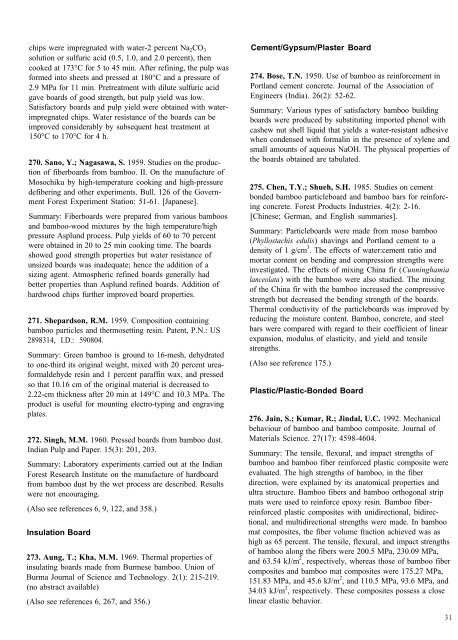Literature Review on Use of Nonwood Plant Fibers for Building ...
Literature Review on Use of Nonwood Plant Fibers for Building ...
Literature Review on Use of Nonwood Plant Fibers for Building ...
Create successful ePaper yourself
Turn your PDF publications into a flip-book with our unique Google optimized e-Paper software.
chips were impregnated with water-2 percent Na 2CO 3<br />
soluti<strong>on</strong> or sulfuric acid (0.5, 1.0, and 2.0 percent), then<br />
cooked at 173°C <strong>for</strong> 5 to 45 min. After refining, the pulp was<br />
<strong>for</strong>med into sheets and pressed at 180°C and a pressure <strong>of</strong><br />
2.9 MPa <strong>for</strong> 11 min. Pretreatment with dilute sulfuric acid<br />
gave boards <strong>of</strong> good strength, but pulp yield was low.<br />
Satisfactory boards and pulp yield were obtained with waterimpregnated<br />
chips. Water resistance <strong>of</strong> the boards can be<br />
improved c<strong>on</strong>siderably by subsequent heat treatment at<br />
150°C to 170°C <strong>for</strong> 4 h.<br />
270. Sano, Y.; Nagasawa, S. 1959. Studies <strong>on</strong> the producti<strong>on</strong><br />
<strong>of</strong> fiberboards from bamboo. II. On the manufacture <strong>of</strong><br />
Mosochiku by high-temperature cooking and high-pressure<br />
defibering and other experiments. Bull. 126 <strong>of</strong> the Government<br />
Forest Experiment Stati<strong>on</strong>: 51-61. [Japanese].<br />
Summary: Fiberboards were prepared from various bamboos<br />
and bamboo-wood mixtures by the high temperature/high<br />
pressure Asplund process. Pulp yields <strong>of</strong> 60 to 70 percent<br />
were obtained in 20 to 25 min cooking time. The boards<br />
showed good strength properties but water resistance <strong>of</strong><br />
unsized boards was inadequate; hence the additi<strong>on</strong> <strong>of</strong> a<br />
sizing agent. Atmospheric refined boards generally had<br />
better properties than Asplund refined boards. Additi<strong>on</strong> <strong>of</strong><br />
hardwood chips further improved board properties.<br />
271. Shepards<strong>on</strong>, R.M. 1959. Compositi<strong>on</strong> c<strong>on</strong>taining<br />
bamboo particles and thermosetting resin. Patent, P.N.: US<br />
2898314, I.D.: 590804.<br />
Summary: Green bamboo is ground to 16-mesh, dehydrated<br />
to <strong>on</strong>e-third its original weight, mixed with 20 percent urea<strong>for</strong>maldehyde<br />
resin and 1 percent paraffin wax, and pressed<br />
so that 10.16 cm <strong>of</strong> the original material is decreased to<br />
2.22-cm thickness after 20 min at 149°C and 10.3 MPa. The<br />
product is useful <strong>for</strong> mounting electro-typing and engraving<br />
plates.<br />
272. Singh, M.M. 1960. Pressed boards from bamboo dust.<br />
Indian Pulp and Paper. 15(3): 201, 203.<br />
Summary: Laboratory experiments carried out at the Indian<br />
Forest Research Institute <strong>on</strong> the manufacture <strong>of</strong> hardboard<br />
from bamboo dust by the wet process are described. Results<br />
were not encouraging.<br />
(Also see references 6, 9, 122, and 358.)<br />
Insulati<strong>on</strong> Board<br />
273. Aung, T.; Kha, M.M. 1969. Thermal properties <strong>of</strong><br />
insulating boards made from Burmese bamboo. Uni<strong>on</strong> <strong>of</strong><br />
Burma Journal <strong>of</strong> Science and Technology. 2(1): 215-219.<br />
(no abstract available)<br />
(Also see references 6, 267, and 356.)<br />
Cement/Gypsum/Plaster Board<br />
274. Bose, T.N. 1950. <strong>Use</strong> <strong>of</strong> bamboo as rein<strong>for</strong>cement in<br />
Portland cement c<strong>on</strong>crete. Journal <strong>of</strong> the Associati<strong>on</strong> <strong>of</strong><br />
Engineers (India). 26(2): 52-62.<br />
Summary: Various types <strong>of</strong> satisfactory bamboo building<br />
boards were produced by substituting imported phenol with<br />
cashew nut shell liquid that yields a water-resistant adhesive<br />
when c<strong>on</strong>densed with <strong>for</strong>malin in the presence <strong>of</strong> xylene and<br />
small amounts <strong>of</strong> aqueous NaOH. The physical properties <strong>of</strong><br />
the boards obtained are tabulated.<br />
275. Chen, T.Y.; Shueh, S.H. 1985. Studies <strong>on</strong> cement<br />
b<strong>on</strong>ded bamboo particleboard and bamboo bars <strong>for</strong> rein<strong>for</strong>cing<br />
c<strong>on</strong>crete. Forest Products Industries. 4(2): 2-16.<br />
[Chinese; German, and English summaries].<br />
Summary: Particleboards were made from moso bamboo<br />
(Phyllostachis edulis) shavings and Portland cement to a<br />
density <strong>of</strong> 1 g/cm 3 . The effects <strong>of</strong> water:cement ratio and<br />
mortar c<strong>on</strong>tent <strong>on</strong> bending and compressi<strong>on</strong> strengths were<br />
investigated. The effects <strong>of</strong> mixing China fir (Cunninghamia<br />
lanceolata) with the bamboo were also studied. The mixing<br />
<strong>of</strong> the China fir with the bamboo increased the compressive<br />
strength but decreased the bending strength <strong>of</strong> the boards.<br />
Thermal c<strong>on</strong>ductivity <strong>of</strong> the particleboards was improved by<br />
reducing the moisture c<strong>on</strong>tent. Bamboo, c<strong>on</strong>crete, and steel<br />
bars were compared with regard to their coefficient <strong>of</strong> linear<br />
expansi<strong>on</strong>, modulus <strong>of</strong> elasticity, and yield and tensile<br />
strengths.<br />
(Also see reference 175.)<br />
Plastic/Plastic-B<strong>on</strong>ded Board<br />
276. Jain, S.; Kumar, R.; Jindal, U.C. 1992. Mechanical<br />
behaviour <strong>of</strong> bamboo and bamboo composite. Journal <strong>of</strong><br />
Materials Science. 27(17): 4598-4604.<br />
Summary: The tensile, flexural, and impact strengths <strong>of</strong><br />
bamboo and bamboo fiber rein<strong>for</strong>ced plastic composite were<br />
evaluated. The high strengths <strong>of</strong> bamboo, in the fiber<br />
directi<strong>on</strong>, were explained by its anatomical properties and<br />
ultra structure. Bamboo fibers and bamboo orthog<strong>on</strong>al strip<br />
mats were used to rein<strong>for</strong>ce epoxy resin. Bamboo fiberrein<strong>for</strong>ced<br />
plastic composites with unidirecti<strong>on</strong>al, bidirecti<strong>on</strong>al,<br />
and multidirecti<strong>on</strong>al strengths were made. In bamboo<br />
mat composites, the fiber volume fracti<strong>on</strong> achieved was as<br />
high as 65 percent. The tensile, flexural, and impact strengths<br />
<strong>of</strong> bamboo al<strong>on</strong>g the fibers were 200.5 MPa, 230.09 MPa,<br />
and 63.54 kJ/m 2 , respectively, whereas those <strong>of</strong> bamboo fiber<br />
composites and bamboo mat composites were 175.27 MPa,<br />
151.83 MPa, and 45.6 kJ/m 2 , and 110.5 MPa, 93.6 MPa, and<br />
34.03 kJ/m 2 , respectively. These composites possess a close<br />
linear elastic behavior.<br />
31

















